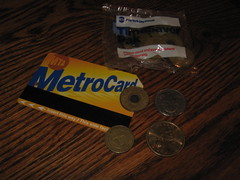Stock up on those $76 MetroCards while you still can.
The MTA Board has voted to approve the proposed fare hike. Beginning March 2, 2008, fares for New York City buses and subways will increase. CityRoom has the story:
The majority of riders — who use unlimited-ride MetroCards or get a discount for buying multiple rides at once — will have to pay more, starting on March 2. The costs of unlimited-ride cards will rise to $81 from $76 for the 30-day card and to $25 from $24 for the 7-day card; a new 14-day card will be sold for $47.
The bonus for regular pay-per-ride cards will be reduced to 15 percent from 20 percent, but the threshold for receiving the bonus will also be reduced, to $7 from $10. With the bonuses in place, the average cost of a bonus ride will rise to $1.74 from $1.67. The express bus fare ($5) and the cost of a 7-day express bus pass ($41) remain unchanged.
As anyone who follows New York politics knows, the fare hike debate has been raging for much of the last two months. The MTA wanted a higher increase and a base-fare hike as well, but Gov. Spitzer, ever mindful of those tourists in New York, decided he would rather screw over the regular commuters with a token gesture that keeps the base fare at $2 and didn’t really help his sagging approval ratings anyway.
While the MTA has long pushed this fare hike an important step on the road to fiscal responsibility, opponents of the hike have urged the agency to wait a few months for Albany to kick back some money. “I think there’s no harm in waiting until July 1, to keep the pressure on Albany and to ensure they come through for the M.T.A.,” MTA Board Member and fare hike dissenter Andrew Saul said. “By taking the pressure off Albany at this point, it’s a bad mistake for us.”
But other members on the MTA Board recognized the Authority’s tenuous financial situation. Barry Feinstein, an appointee of the governor, noted that the MTA faces a “dog fight” for state funding, and Susan Metzger appreciated the efforts by the MTA to ween itself off of tax windfalls. “This is a very hard decision for all of us too make, and it’s an unpopular one but it’s a first step toward fiscal responsibility,” she said. The MTA, she noted, can no longer turn “a blind eye to our responsiblity to put the MTA on a firm future monetary structure.”
Hikes will go into effect on March 1 for MetroNorth and LIRR riders and March 16 for Bridge and Tunnel users.



 Finally – finally – after a long Halt the Hike campaign that blended journalism and public advocacy reporting, the Daily News has produced a story that shows the deep-rooted institutional problems inherit in the MTA.
Finally – finally – after a long Halt the Hike campaign that blended journalism and public advocacy reporting, the Daily News has produced a story that shows the deep-rooted institutional problems inherit in the MTA. At the end of the day on Friday — always an odd time to make a major announcement — the MTA announced increased service at all times along the L and 7, their two favorite test lines. This move came in response to the subpar scores these lines received on their Rider Report Cards.
At the end of the day on Friday — always an odd time to make a major announcement — the MTA announced increased service at all times along the L and 7, their two favorite test lines. This move came in response to the subpar scores these lines received on their Rider Report Cards.  Before getting to the record low two weekend service changes, let’s journey down to Washington, D.C. for a brief jaunt. The Washington Metropolitan Area Transportation Authority just unveiled
Before getting to the record low two weekend service changes, let’s journey down to Washington, D.C. for a brief jaunt. The Washington Metropolitan Area Transportation Authority just unveiled 
